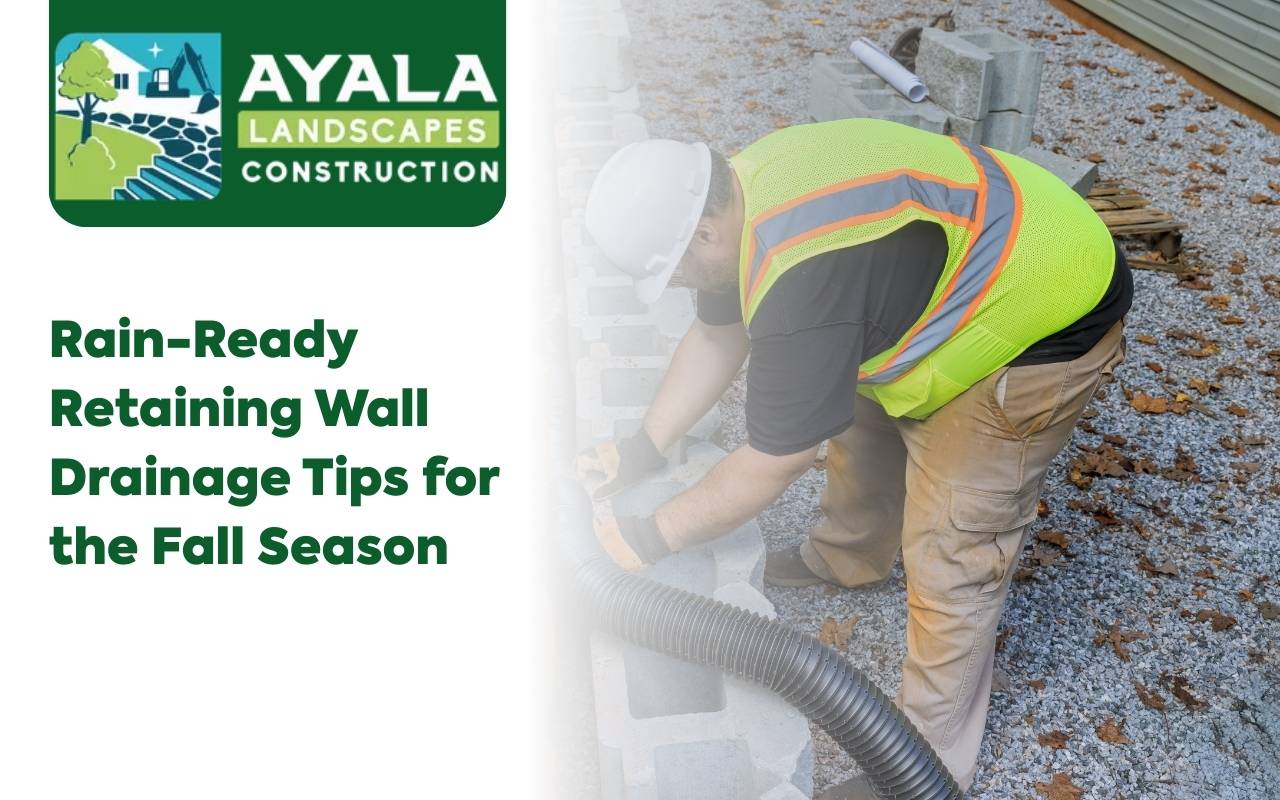
As the leaves turn amber and the air grows crisp, fall offers beauty and challenges. Rainstorms can saturate soil and pressure retaining walls. Without proper solutions, costly damage occurs. Retaining wall drainage tips for rainy season protect structures, prevent erosion, and secure landscapes. Preparing now ensures safety and peace of mind. This guide explores strategies to safeguard your property before heavy rains arrive.
Importance of Proper Retaining Wall Drainage
Drainage is the foundation of a stable retaining wall. Water buildup creates hydrostatic pressure, risking cracks, bulges, or collapse. Applying retaining wall drainage tips for rainy season prevents damage by channeling water away. These strategies also maintain soil stability and keep wall faces clean and dry. Add solutions like weep holes or hidden drainpipes for consistent performance. Proper planning reduces long-term maintenance costs and secures the landscape’s beauty.
Signs of Poor Drainage in Retaining Walls
- Cracks running horizontally or vertically across wall surfaces
- Bulging sections caused by saturated soil pushing outward
- Leaning walls that tilt toward the backfill
- Soggy patches, pooling water, or surface stains
- Moss, mold, or lush vegetation near the wall
Spotting these early signals allows timely corrections. Regular inspections in the fall rainy season prevent costly structural repairs. Simple retaining wall drainage tips for rainy season keep issues manageable.
Clearing Drainage Pathways: Essential Preparation Steps
Leaves, soil, and roots block drainage paths. Clear them before storms arrive. Clean weep holes with a stiff brush or auger. Flush with water to confirm flow. Inspect trenches to locate blockages in drainpipes or fabrics. These steps ensure advanced solutions like French drains perform effectively. Preparing drainage systems protects walls from sudden downpours.
Installing French Drains: A Key Component for Effective Drainage
- Dig a trench with a slight slope away from the wall
- Line trench with landscape fabric to block soil infiltration
- Add a gravel layer and place perforated pipe with holes facing downward
- Cover pipe with gravel, fold fabric, and backfill with soil
- Direct water into safe discharge zones like swales or storm sewers
This system reduces pressure behind walls and handles large volumes of autumn rainfall. Pairing with other retaining wall ideas creates complete water management solutions.
Choosing the Right Drainage Gravel: Factors to Consider
Drainage gravel ensures free water flow behind retaining walls. Select angular, crushed stone like granite or limestone. Avoid river rocks, fines, or sand that reduce permeability. Use washed gravel, 6–12 inches thick, tapering to the drainpipe. Pair with filter fabric for lasting performance. Combining functional gravel with decorative stone skirts enhances both structure and landscape design.
Implementing Erosion Control Measures Around Retaining Walls
Drainage alone is insufficient without erosion control. Heavy rains can wash soil from behind walls. Use geotextile fabrics, biodegradable erosion mats, or vegetation with strong roots. Creeping juniper or native grasses stabilize soil and minimize runoff. Together, these tools support retaining wall drainage tips for rainy season and keep landscapes intact.
Rain-Ready Landscaping Tips to Support Retaining Wall Drainage
- Extend downspouts and use splash blocks to divert roof water
- Create swales to guide runoff into French drains
- Install rain gardens or dry creek beds with decorative stone
- Choose plants that thrive in moist soil, such as sedges and grasses
- Apply mulch lightly to avoid compaction and poor infiltration
Landscaping choices work hand-in-hand with drainage systems. These steps protect retaining walls, reduce runoff, and enhance curb appeal.
Regular Maintenance Practices to Ensure Optimal Drainage Performance
Seasonal maintenance prevents failures. Remove leaves and sediment from drains and gutters. Flush weep holes with water. Replenish displaced gravel near French drains. Inspect wall alignment with a plumb line or level. Schedule professional inspections for larger walls. Consistent upkeep ensures drainage systems work effectively against fall rainstorms.
FAQs on Retaining Wall Drainage Tips
How often should I inspect my retaining wall?
Inspect at least twice a year, preferably in spring and fall. Regular checks catch small drainage issues early.
Do French drains work for all wall types?
French drains suit most walls but require correct placement and slope. Professional advice helps with complex sites.
What plants best support drainage around walls?
Choose deep-rooted grasses, sedges, or groundcovers. They stabilize soil and absorb excess water effectively.
How do I know if drainage gravel is clogged?
Pooling water or damp soil near the wall often indicates clogged gravel layers. Regular flushing prevents this issue.
When should I call a professional?
Seek professional help if cracks widen, walls lean significantly, or washouts occur despite routine maintenance efforts.
Professional Assistance: When to Seek Help with Retaining Wall Drainage
Some drainage issues demand expert solutions. Structural cracks, severe bowing, or persistent water problems require professional assessment. Licensed contractors use soil tests and engineering designs to create safe drainage systems. For walls over four feet or steep slopes, experts ensure compliance with codes and safety standards. When in doubt, professional help guarantees durable and secure retaining walls.
Your Rain-Ready Retaining Walls – Ready for Fall Challenges
Proper water management ensures your retaining walls stand strong during fall rains. By combining clearing, French drains, quality gravel, and erosion control, you protect your investment. Pair these methods with thoughtful landscaping and consistent maintenance for long-term success. Discover
retaining wall solutions tailored to your property. For complete services, explore our
landscaping services and
concrete work. If you need expert help,
contact us today and secure your landscape against the season’s rain.
